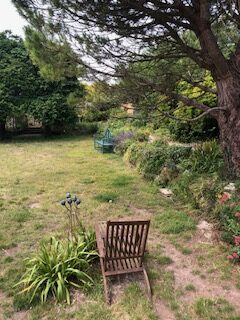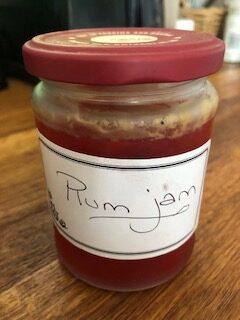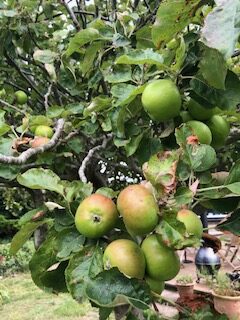Having been battered with bad news this week, I was at a loss as to what to write. My head is whirling like a rotary drier and all thoughts seem to have spun away like poorly secured socks. My husband suggested that I write about the garden and, since it is my solace always, I thought it would be a good place to start. If nothing else, I could post some pastoral pictures.

Image: Karen Costello-McFeat
At last the temperature seems to match the month and it is a balmy 24 degrees here. The air is unusually still and the garden seems to have settled into a summer doze.
The vibrant greens of spring have been replaced with the muted tones of khaki. With many of the flowering plants past their glory, they have left behind an infinite array of leaf shapes and seed heads.
First fruits
All the rain this year has had some benefits. My soft fruits have been unusually plentiful. Each morning, I would trundle down the garden and pick blackcurrants, red currants, raspberries, plums and mulberries. Some of them even made it back to the kitchen.


Delicious as soft fruits are, there is a limit to how many one can consume at a time, so after giving away quite a few, the rest were placed in bags and into the freezer.
Preserving summer
With my final plums ripening faster than I could eat them, I took the last batch to make some jam. And jam making need not be an all-day affair. Making a smaller amount in a heavy bottomed pan takes hardly any time at all. The result was just two jars – one for me, one for my mum. Perfect.

My gnarly old cooking apple tree seems to be preparing for a bumper crop this year. Yet, high winds and inclement weather meant that quite a few of its fruits ended up on the ground. Unwilling to lose even these, I set about making apple cider vinegar. It is used in so many plant-based recipes that it seemed crazy not to make my own. It’s also excellent for descaling the kettle.

Windfall apple cider couldn’t be easier to make. Sterilize a large jar, add chopped apples (or apple peel). Add about 1/2 cup of sugar and fill the jar with boiled or purified water. Stir. Cover with a cloth tied with an elastic band. Stir each morning and it should be ready in one month when it has a strong vinegary smell. (If you want to be precise, invest in PH strips!)
Autumn promise
Having enjoyed so much plenty from the garden, it seems a little greedy to ask for more – but more is what is promised. My pear trees are all laden, as are the more mature apple trees (the babies haven’t got there yet!) My additional plum trees should be ready to harvest soon and the quinces at the very tail end of autumn.

Image: Karen Costello-McFeat
However, lest you think that all my gardening attempts have been successful, be assured that my foes have done their upmost to thwart me.
Garden foes
This year, the slugs and snails have surpassed themselves. They look so cute (well, snails at least) and wreck total havoc. Perhaps they have taken an evolutionary leap, because I keep finding them up my trees. When did they learn to climb?



And as for bindweed, it is my nemesis. No walk in the garden is complete without gathering armfuls of the stuff and unravelling its stranglehold on my plants. Its gorgeous flower trumpets its triumph. Honestly, that is just rude.
In addition to our fruit trees, we attempted to grow maize, squashes, butternut squash, peas and beans. The beans and peas and half the squashes are currently working their way through the snails’ digestive tracts and I am only hoping that the few remaining survivors are safe, because they are satiated.
My husband suggested that some mad scientist ought to make a genetically modified snail to eat bindweed. A fortune awaits!
Summer residents
Though weeds and slugs are unwanted guests, the vast majority of creatures who make my garden home are warmly accepted. Butterflies, birds, ants, pollinators, and tiny gnats are all part of an ecology that makes everything thrive and transforms the garden from a green space to a living organism.

Image: Karen Costello-Feat
Out with the old and in with the new
Nature is not remotely sentimental about keeping things beyond the date of their usefulness. Once a flower has bloomed, hopefully been pollinated and spread its seed, it is time for the next contender for her precious resources.
The garden is now filled with seed heads and fluffy cones of valerian. In their place are dazzling displays of Michaelmas daisies, reborn roses and sun loving geraniums. But their time too is marked, as the Earth tilts towards autumn.


Across the road, in a neighbour’s tree, the first flame coloured leaves have appeared. It will be a month or two before the tree is fully ablaze, but notice has been given.
For some, the fleeting nature of things is a source of sorrow. The children, soon to depart school for the holidays, no doubt wish that summer would never end. But for me, it is the constant changing cycle that I find comforting and enthralling. The garden is a symbol of both fragility and endurance. Nothing is ever truly lost – only reimagined for a time.

First of all I want to say awesome blog! I had a
quick question which I’d like to ask if you don’t mind.
I was interested to find out how you center yourself and clear your minbd priuor to
writing. I have had a tough time clearing my mind in getting my ideas out.
I truly do take pleasure in writing but it just seems
like the first 10 to 15 minutes tend to be wasted just trying
to figure out how to begin. Any ideas oor hints?
Appreciate it! https://zeleniymis.com.ua/
I understand your dilemma – for lots of ideas on how to begin see my blog from a few weeks ago entitled Blank – on ways to begin writing. Good luck!